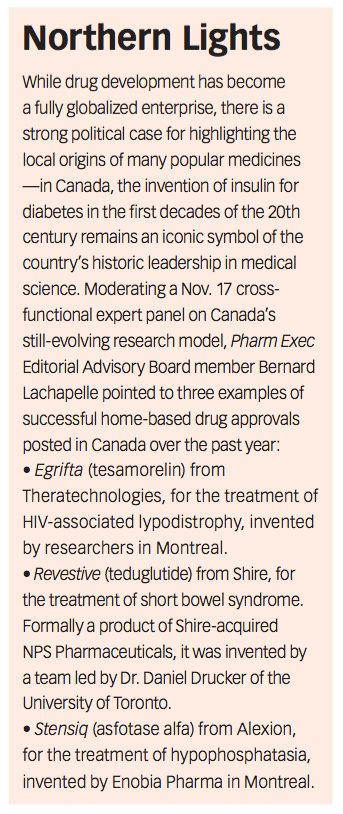Canada's Rx&D: Fresh Start for a New Era
Pharmaceutical Executive
Canada’s Rx&D, the industry’s oldest functioning trade association, recently changed its name-with a mission of bridging the many points of collaboration that drive the process of modern drugs, from discovery to market.
As the reputational challenges to big Pharma progress from bad to worse, what steps are the industry’s trade associations taking to reverse the slide? Worth citing for its wider implications is the overhaul that Canada’s Rx&D, the industry’s oldest functioning trade association, has just given itself to

commemorate 100 years of representing the interests of local patented drugmakers. On Jan. 4, Rx&D formally changed its name to Innovative Medicines Canada, replacing its single pill-form logo with a floating, dot-connected circle designed to represent the many points of collaboration that drive the process of modern drugs, from discovery to the market. In addition, the group adopted a new five-point mission to provide a long-term structure to its relationships with patients, providers, regulators, and others. Specifically, Innovative Medicines Canada will work to:
- Ensure patients have access to the innovative treatments they need.
- Lead Canada with the discovery of innovative treatments for longer, healthier lives.
- Support balanced patented drug regulations that are predictable and equitable for innovators.
- Set high standards for ethical and open practices that respect the relationships between our employees, the life sciences sector, healthcare professionals, and the public.
- Cooperate with all healthcare partners to provide patients with the information and tools they need to take their medicines safely and effectively.
In policy shorthand, the new mission commits the R&D industry to promote increased patient access to breakthrough drugs through a strong domestic and international research profile; protect basic rules of IP that recognize the upfront financial risks assumed by inventors; advance a promotional controls and ethics agenda that has made the Canadian industry a world-class leader in compliance; and contribute to appropriate drug utilization through improved patient adherence to drug therapy.
“Our approach is to emphasize that innovation is not just about what we do, but how we do it,” Innovative Medicines Canada President Russell Williams told Pharm Exec. The strategy is also strongly inclusive, rooted

in a program called “100 Conversations” launched in the organization’s 2015 centenary year by Board of Directors chair Michael Tremblay of Astellas Pharma Canada.
At a recent symposium, Tremblay noted that the consultations with the health community were the most extensive ever by the industry-designed to cement its bona fides around the partnering required to move the needle on the industry’s three-year strategic plan. That commits the organization as a solutions-oriented driver of efficient regulation, one that increases drug access through clear approval pathways, consistent use of objective evidence, a better climate for attracting clinical trials, and a “globally competitive” IP regime. Through 2018, expect to hear the new Innovative Medicines Canada initiate a national dialogue around the one question that strikes at the heart of Canada’s public health dilemma-why a country with a historically strong research base and significant assets of human capital, located astride the world’s largest market for new health technologies, continues to punch below its weight in turning good science into great products. It’s all about this, says Tremblay: “What is the cost of not innovating? Of not prolonging life, treating chronic diseases, and promoting wellness? Most important, are we as a country willing to pay that price?”
Timing of the overhaul is opportune. New Prime Minister Justin Trudeau has declared its time for the country to move from a resource-based economy to one focused on “resourcefulness”-“on what’s between our ears rather than below our feet.” In two languages, Innovation Canada is resolving to hold him to the promise.
William Looney is Pharm Exec’s Editor-in-Chief. He can be reached at wlooney@advanstar.com

FDA Grants Priority Review to Regeneron’s Eylea for Macular Edema Following Retinal Vein Occlusion
April 18th 2025Regulatory action was based on data from the Phase III QUASAR trial, which demonstrated that Eylea HD dosed every eight weeks achieved non-inferior visual acuity outcomes compared to Eylea in patients with macular edema following retinal vein occlusion.
Addressing Disparities in Psoriasis Trials: Takeda's Strategies for Inclusivity in Clinical Research
April 14th 2025LaShell Robinson, Head of Global Feasibility and Trial Equity at Takeda, speaks about the company's strategies to engage patients in underrepresented populations in its phase III psoriasis trials.
New Insights Into T Cell Exhaustion and Inflammation in Long COVID
April 17th 2025Nigel McCracken, chief operating officer, Virax Biolabs, discusses new findings that reveal altered cytokine activity and evidence of T cell exhaustion in long COVID patients, providing deeper insight into post-infection immune disruption.
Key Findings of the NIAGARA and HIMALAYA Trials
November 8th 2024In this episode of the Pharmaceutical Executive podcast, Shubh Goel, head of immuno-oncology, gastrointestinal tumors, US oncology business unit, AstraZeneca, discusses the findings of the NIAGARA trial in bladder cancer and the significance of the five-year overall survival data from the HIMALAYA trial, particularly the long-term efficacy of the STRIDE regimen for unresectable liver cancer.
Amgen’s Imdelltra Demonstrates Significant Overall Survival Improvement in Small Cell Lung Cancer
April 16th 2025In the Phase III DeLLphi-304 trial, patients with small cell lung cancer administered Imdelltra achieved a statistically significant and clinically meaningful improvement in overall survival compared to standard-of-care chemotherapy.